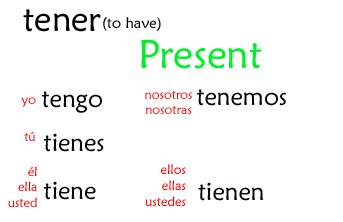 6. Diego hasnt come to work this week. For regular verbs, the past participle of verb is the regular past simple form (verb + -ed). Celia hasnt showered today. 6. But we actually use haber instead, which also translates as to have. Past Participles in English are words
Algo ms que puedes hacer es escribir un anecdotario, ah puedes incluir diferentes experiencias que has vivido a lo largo de tu vida, como un diario, pero en ingls y tratando de utilizar elpresent perfecty tal vez contrastarlo con elpast simple. Hoy desayun con mis amigas. Incluso si algo ocurri five minutes ago, ya es pasado! On the other hand, Spanish preterite is used to talk about actions that were completed at some point in the past. Bill and Doug broke your phone. As a native speaker, I think that this is an easy tense to learn. Bill y Doug han descompuesto tu telfono. vs. "swollen"? It is not used for specific actions. have taken place in the past (they are completed actions), they still have
6. Diego hasnt come to work this week. For regular verbs, the past participle of verb is the regular past simple form (verb + -ed). Celia hasnt showered today. 6. But we actually use haber instead, which also translates as to have. Past Participles in English are words
Algo ms que puedes hacer es escribir un anecdotario, ah puedes incluir diferentes experiencias que has vivido a lo largo de tu vida, como un diario, pero en ingls y tratando de utilizar elpresent perfecty tal vez contrastarlo con elpast simple. Hoy desayun con mis amigas. Incluso si algo ocurri five minutes ago, ya es pasado! On the other hand, Spanish preterite is used to talk about actions that were completed at some point in the past. Bill and Doug broke your phone. As a native speaker, I think that this is an easy tense to learn. Bill y Doug han descompuesto tu telfono. vs. "swollen"? It is not used for specific actions. have taken place in the past (they are completed actions), they still have
 6. Diego hasnt come to work this week. For regular verbs, the past participle of verb is the regular past simple form (verb + -ed). Celia hasnt showered today. 6. But we actually use haber instead, which also translates as to have. Past Participles in English are words
Algo ms que puedes hacer es escribir un anecdotario, ah puedes incluir diferentes experiencias que has vivido a lo largo de tu vida, como un diario, pero en ingls y tratando de utilizar elpresent perfecty tal vez contrastarlo con elpast simple. Hoy desayun con mis amigas. Incluso si algo ocurri five minutes ago, ya es pasado! On the other hand, Spanish preterite is used to talk about actions that were completed at some point in the past. Bill and Doug broke your phone. As a native speaker, I think that this is an easy tense to learn. Bill y Doug han descompuesto tu telfono. vs. "swollen"? It is not used for specific actions. have taken place in the past (they are completed actions), they still have
6. Diego hasnt come to work this week. For regular verbs, the past participle of verb is the regular past simple form (verb + -ed). Celia hasnt showered today. 6. But we actually use haber instead, which also translates as to have. Past Participles in English are words
Algo ms que puedes hacer es escribir un anecdotario, ah puedes incluir diferentes experiencias que has vivido a lo largo de tu vida, como un diario, pero en ingls y tratando de utilizar elpresent perfecty tal vez contrastarlo con elpast simple. Hoy desayun con mis amigas. Incluso si algo ocurri five minutes ago, ya es pasado! On the other hand, Spanish preterite is used to talk about actions that were completed at some point in the past. Bill and Doug broke your phone. As a native speaker, I think that this is an easy tense to learn. Bill y Doug han descompuesto tu telfono. vs. "swollen"? It is not used for specific actions. have taken place in the past (they are completed actions), they still have